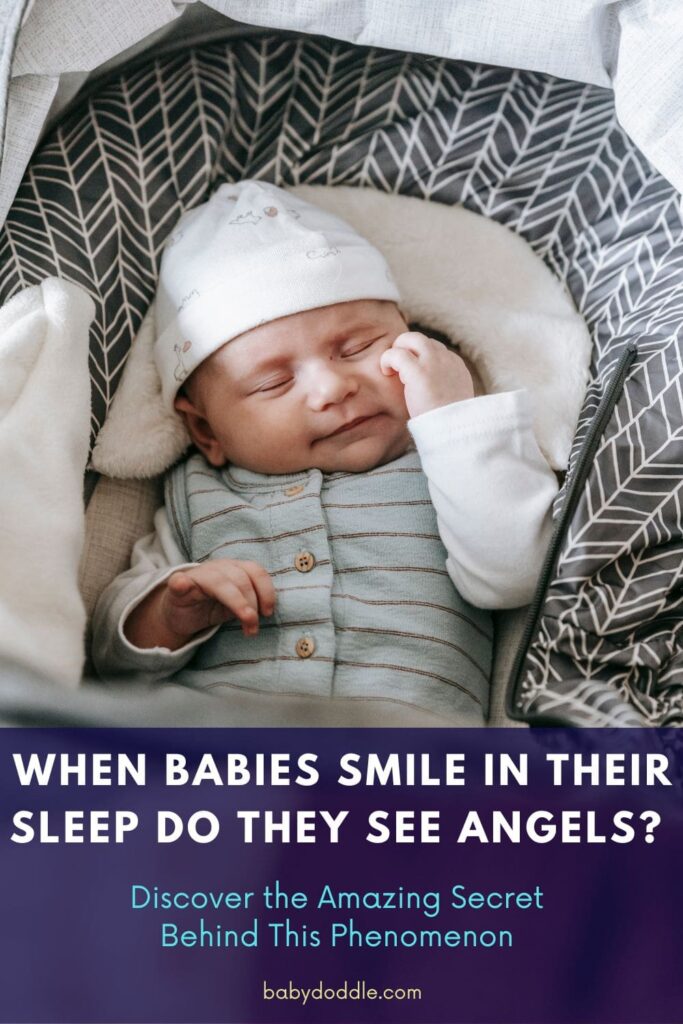As a parent, few things melt your heart more than glimpsing your sleeping baby with a sweet, angelic smile on their face. In those serene moments, it’s natural to wonder – When Babies Smile in Their Sleep Do They See Angels? Do babies have some spiritual connection we can’t quite comprehend?
I know the first time I witnessed my daughter’s peaceful slumber give way to a glowing grin, I was convinced heavenly guardians were making their presence known. It just seemed too magical to be ordinary dream images dancing through her head.
As it turns out, there are some surprising scientific and spiritual insights into why babies smile in their sleep. And while concrete proof of angel sightings remains elusive, there are plenty of thought-provoking theories to discover. Let’s delve into this fascinating phenomenon together!
The Science Behind Infant Sleep Cycles
As babies journey through their first year, they cycle through various stages of sleep just like adults. Each phase serves important functions for development, health, and growth. Understanding the science behind your baby’s slumber provides helpful context for phenomena like smiling during sleep.
In the first few months of infancy, babies spend about 50% of sleep time in active or REM sleep when dreams occur. They also transition between lighter non-REM stages and deeper delta wave stages multiple times throughout naps and nighttime.
By 6 months old, melatonin secretion helps consolidate night sleep into longer stretches. Babies also start developing true circadian rhythms around this time. Sleep starts reflecting more adult-like patterns and cycles.
So what does this all mean for interpreting your snoozing baby’s smile? Well, by 2 to 3 months when non-REM/REM cycling regulates, chances increase of visibly pleasant, animated dreams translating into happy expressions. The scientific foundations for quality sleep – and all the adventures dreaming allows fall into place.
What Makes Babies Smile in Their Sleep in the First Place?
Before examining mystical explanations, it helps to understand what we know about more earthly reasons you may see your sleeping babe suddenly don a dazzling display of joy. There are a few key factors that can spur a snoozing baby’s smiles.
Dreaming
Just like adults, babies spend a good portion of their sleep time in rapid eye movement (REM) sleep when most vivid dreams occur. While we can’t know exactly what they’re envisioning, it’s possible humorous or pleasant images translate into outward grins. Their dreams may not be as complex as ours, but neurological studies confirm babies do dream.
Digestive Causes
An uncomfortable truth resides in that cute belly of theirs. Gas pains or reflux could cause sleeping smiles too. If the grin coincides with fart noises or other stomach rumblings, this explanation may burst your angel bubble a bit!
General Comfort
Babies smile more often in their first few months than at any other time in life. Their grins emerge as a reflex – they can’t help but beam when all their needs are met and they feel cozy. The comfort of their sleeping space may prompt joy spillover into dreamland.
Of course, reasoning things out with statistics and studies only goes so far. At the end of the day a parent’s intuition, faith or gut feeling plays a mighty role. So let’s leave room for a bit of magic, shall we?
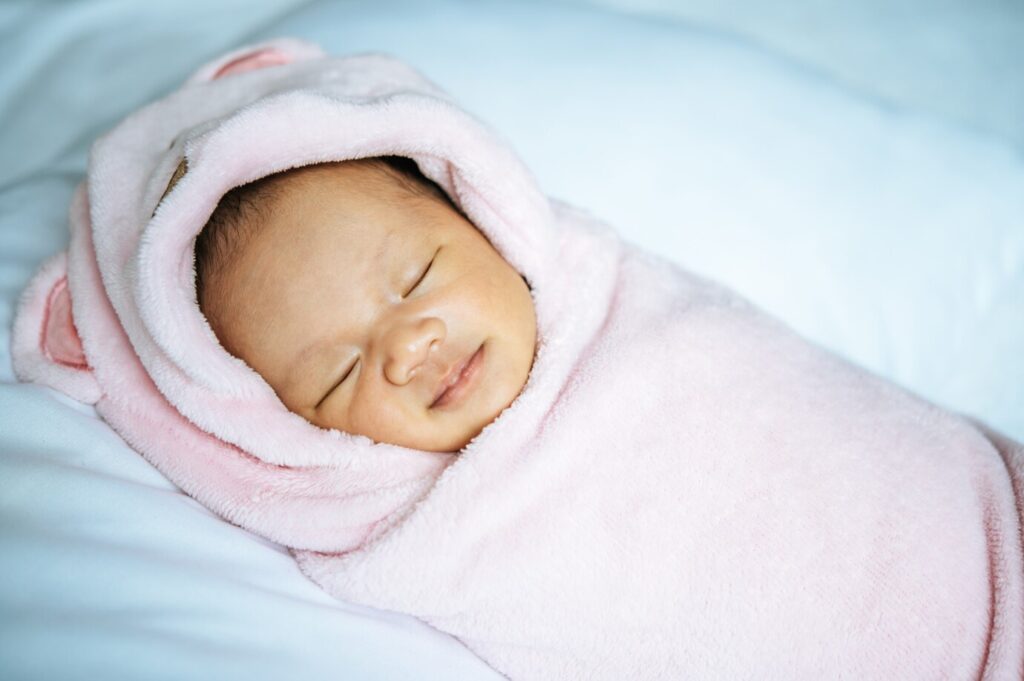
Angelic Encounters Throughout History
While your baby’s angelic sleep smiles stir speculation about mystical messengers, history brims with tales of angelic sightings that make doubting their existence difficult.
In Catholic lore, famous children like Fatima visionaries Lucia, Jacinta, and Francisco reported monthly visitations from a radiant “lady from heaven.” Miracles like saving Baby Fae’s life after an angelic dream seem too unbelievable to chalk up solely to coincidence.
Yet cynics argue logical explanations dismiss mystical assumptions about angels’ abilities to penetrate dreams. They highlight scientific causation versus supernatural intervention at play.
Overall, angels hold privileged status in many faiths as guides ushering in human souls – especially children untarnished by earthly troubles. Perhaps their pureness renders their dreams optimal conduits for angel whisperings. And their sleepy smiles simply reflect the residual comfort those connections impart.
Could Messengers From Above Communication With Babies Through Dreams?
Here’s where things get fascinating. What if an infant’s pure heart and very recent descent from the divine makes them more open conduits to the mystical? Some spiritual teachings extend babies privileged status as newly arrived souls, still resonating with the vibration of the non-physical world.
This perspective allows for the profound potential of babies tapping into angelic connections, energy and guidance in ways mostly lost to weary adults. It’s conceivable heavenly helpers utilize babies’ uncluttered dreams to imprint blessings, comfort and love manifesting as smiles.
Religious history brims with tales of angels intervening on children’s behalf – why not infants communicating through extrasensory perceptions beyond our understanding? With open minds and faith in things unseen, perhaps it’s possible to reclaim awe for the everyday miracle asleep in the cradle.
I love this quote that sums up this sense of mystery nicely: “We are all meant to be mothers of God…for God is always needing to be born.” – Meister Eckhart
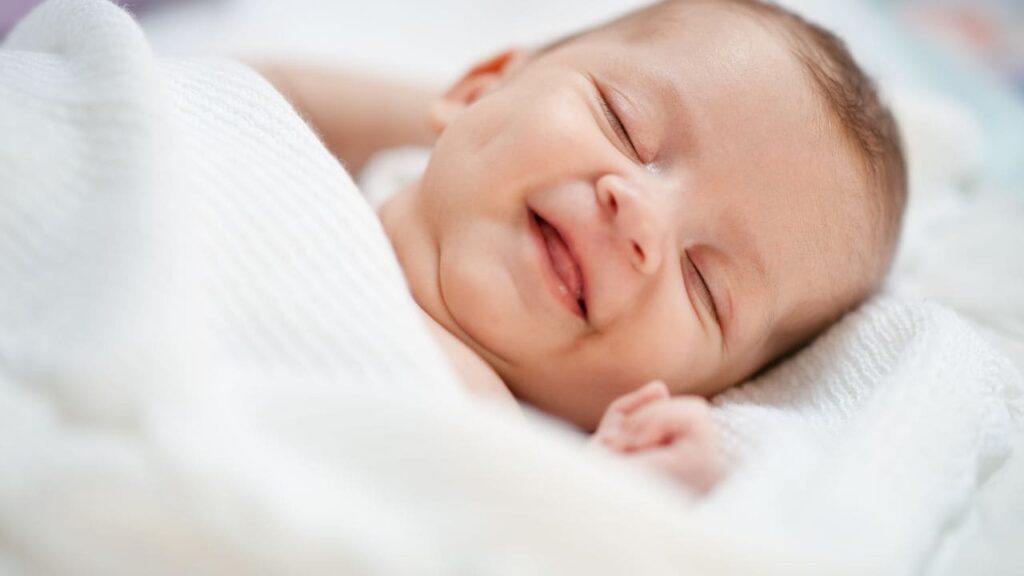
Why Would Angels Be Drawn to Babies in the First Place?
Skeptical or speculative, most parents agree babies radiate a purity we struggle to recapture once grown. Their innocence seems to call forth instinctive protection and gentle handling – not just from mothers, fathers and caregivers, but perhaps angelic guardians as well.
If we believe cherubic assistants exist, babies model the very essence of innocence and goodness they strive to support. And if unseen forces do shepherd young souls, what better time to connect than during peaceful slumber, free of outside stimulation?
I imagine designated angels who watched over my daughter from puffy cloud perches in heaven, only able to make contact once she drifted to sleep. While invisible to the waking eye, her returning smiles convinced me of their cuddly presence.
Of course, I can’t prove this angelic interaction. But a mother’s heart prizes faith over fact. My spirit chose to embrace the beauty of believing in bedside guardian angels eliciting each grin. There was no harm in nurturing this notion, only rich meaning-making to savor.
Earthly Explanations for Sleep Smiles – Don’t Worry, Angels Still Welcome!
However ethereal dreams seem when spying your sleeping baby smile, there may be some less magical reasons at play too – and that’s okay! Learning about developmental stages and milestones can co-exist with mystical musings about angels. Let’s explore some more practical explanations:
Gas or Acid Reflux
An uncomfortable truth resides in that cute belly of theirs. Gas pains or reflux could cause sleeping smiles too. If the grin coincides with fart noises or other tummy rumblings, digestive issues may play a part!
Feeling Safe and Cozy
Remember, babies emit reflexive smiles automatically when comfortable. The womblike warmth and snuggles of bedtime could certainly unleash happy grins. Perhaps they offer visions of mama’s loving face soon after.
Odd Sleep Stage Sensations
Between digestion and dreams, babies cycle through light and deep sleep phases just like adults. Each phase brings different brain wave activity that may cause involuntary muscle movements. Smiles could simply reflect transition sensations.
So while angels always remain a possibility, investigate whether gas or sleeping cycles contribute first. Take comfort in healthy development or medical explanations ruling out scary disorders. Either way, enjoy your baby’s sleeping beauty with a bit of wonder!
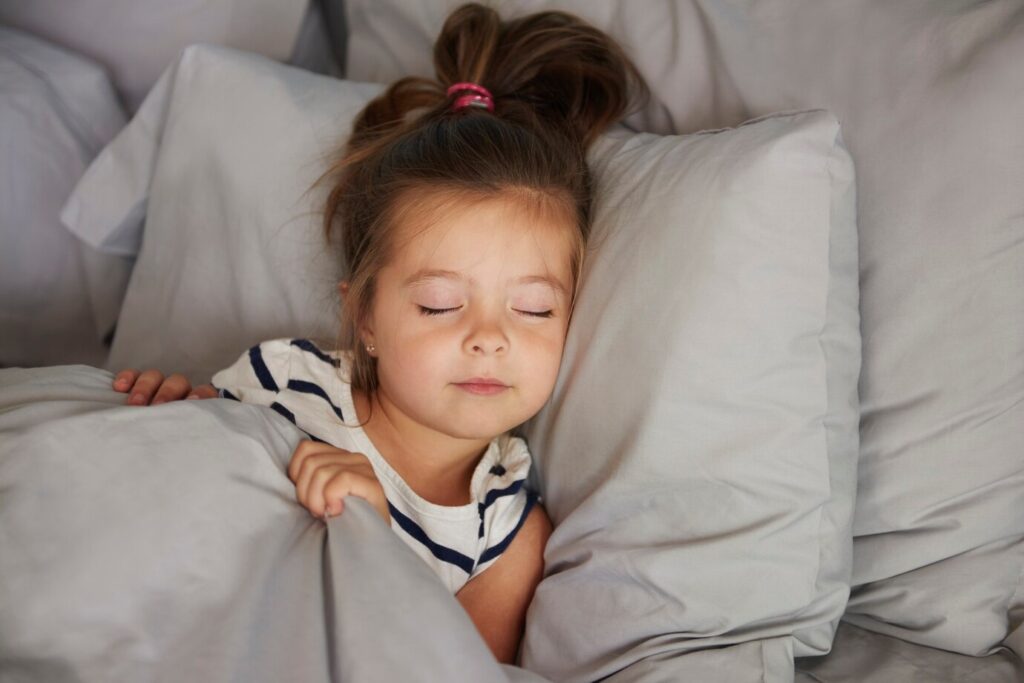
Soothing Techniques for Unsettled Sleepers
Witnessing your baby smile in their sleep offers a profound gift, especially if they struggle with rest at other times. You cherish peaceful moments all the more after bouts of tears, gas and night waking.
If your infant falls into the unsettled sleeper category, plenty of remedies exist for easing bedtime battles. Experiment with different soothing techniques to find the best fit for your child’s needs and temperament.
Natural aids like tight swaddling, white noise and baby massage relax tiny bodies. Gentle sleep training methods can teach self-soothing skills over time. Discuss circulatory boosters or anti-gas drops if pain seems an issue.
Stay attentive as well to signs of reflux, allergies or other medical factors disturbing rest. While hoping angels comfort your baby’s dreams, leave no earthly supports untried either. Sleep struggles pass quicker with attentive parental care.
| Sleep Help | Age Suitability | Directions | Precautions |
|---|---|---|---|
| Swaddling | 0-2 months | Securely wrap blanket/fabric around body/arms | Stop swaddling as soon as baby shows signs of trying to roll over |
| White Noise | Any age | Play ambient shushing sounds before bedtime, naps | Keep volume low enough not to damage hearing |
| Pacifiers | 0-12 months | Give baby dummy nipples to provide sucking comfort | Wean off by 1 year old to avoid bite issues |
| Warm Baths | 6 months + | Bathe 30-60 mins before bed in warm (not hot) water | Avoid emollient bath products interfering with breathing |
| Chamomile Tea | Ages 2+ | Provide half cup to soothe nerves before bed | Avoid honey risk under 12 months; monitor allergies |
| Night Light | Infancy through childhood | Use dim bulbs to emit calming glow after bedtime | No bright/blue wavelength light known to disrupt melatonin |
When Do Snoozing Smiles Typically First Appear?
If you just brought your precious bundle home and can’t wait for glimpses of sleeping smiles, at what age might the phenomenon first appear? Here’s a quick look:
Newborns
Built-in reflexes can lead to flicker smiles from birth, but sleep cycles need to mature before sustained sleep smiles emerge. Their brains are too busy adjusting those first few weeks. But magical dreaming comes soon enough!
6-8 Weeks
By 2 months old, natural cycles of light and deep sleep establish reliable REM dream phases where smiles take hold. As personalities develop, babies also start smiling more in response to familiar voices and faces – even from slumber!
3-4 Months
Genuine social smiles appear, dwarfing newborn reflex grins in length and radiance. Coinciding cognitive changes support dreaming. Sleep smiles should glow bright, lasting several seconds, by mid-infancy.
Of course every child unfolds differently – don’t worry if your baby’s not beaming just yet. But do report lasting odd sleep behaviors to your pediatrician.
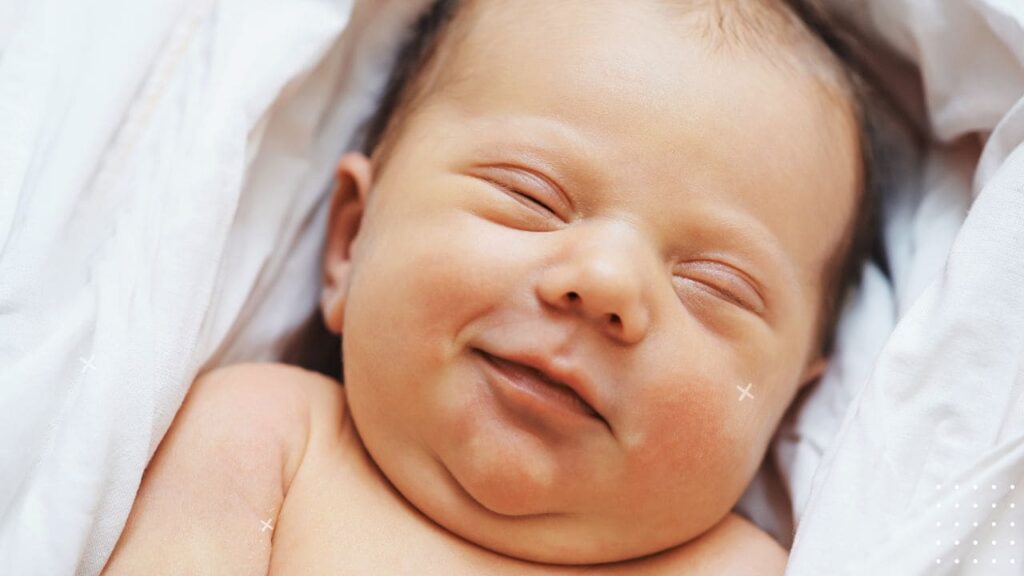
Strange Infant Sleep Habits and What They Mean
In familiarizing yourself with common weird sleep antics, you can rest easy knowing most pass quickly. Familiarity breeds calmer responses.
Moro Reflex
Ever notice your sleeping babe startling themselves awake with jerky limb extensions? This involuntary reflex activates well into infancy. While scary, it protects from real falling danger.
Try swaddling to dull the intensity. And remind yourself of newborn neurological adjustment behind it.
Sleep Talking
Cooing, sputtering, crying and even giggling outbursts come and go with infant sleep fluctuations. Undeveloped pathways between brain and muscles produce interesting sounds!
While annoying, this typically disappears by 18 months old. Just make sure baby stays happily dreaming.
Sleep Starts
Like sleep talking, abrupt body twitches or tics accompany lightweight snoozing for many babies. These usually resolve by 9 months old.
Focus on safety like position and temperature while waiting it out. If concerned, film episodes for your pediatrician.
Sleep Smiles
And back to our main phenomenon! Given all the internal development and dreaming underway, your baby smiling in their sleep surprises no specialists.
Offer comfort for extra squeals and grins if you wish. Then send angels and sweet dreams their way as they smile on.
As you can see, babies engage in all sorts of silly sleep shenanigans as their minds and bodies grow. Smiles and twitches needn’t cause alarm. Stay observant, offer comfort, turn to experts with any concerns – and sprinkle in a little magic along the way!
| Infant Sleep Behavior | Typically Normal Occurrence | Sign of Possible Disordered Sleep |
|---|---|---|
| Moro (Startle) Reflex | Present from birth to 6 months | Persisting past 12 months |
| Sleep Talking | Hack, mumble between cycles | Frequent, loud, clear words |
| Giggling or Squealing | Chirps up to 6 months | Laugh outbursts past 9 months |
| Sleep Starts/Twitches | During light sleep under 9 months | Lasting past 12 months |
| Sleep Smiles | Common by 3-4 months | Only smile reactions for months |
| Bed Wetting | Before 6 months | Over age 5 years old |
Capturing & Cherishing Each Moment
When Luca, my colicky three month old, recently gifted me with angelic sleep smiles three nights in a row, I froze in disbelief. Then I scrambled for my journal and camera wishing to etch the delicate beauty into memory.
New parents often receive advice to cherish each passing moment with your rapidly growing baby. I used to dismiss this as exaggerated sentimentality – until confronting my son’s impending toddlerhood.
Suddenly I ached recalling the way three little chin hairs used to mesmerize me as an infant trademark. When had his milky scent faded? Would I really never cradle impossibly tiny toes against my heart again?
So fellow parents, whether you believe angels elicit bedtime grins or not – document the smiles while they last. Revel in their magical innocence knowing how soon little cheeks lose their round fullness. Let your heart guide you to honor fleeting moments in whatever creative ways speak to your soul.
Freeze glowing sleep smiles into your mind’s scrapbook. Journal whispered conversations, imagining replies. Sketch pillow indentations left behind. And let the imprint of temporary magic carry you through less peaceful phases to come.
Embrace the Mystery and Marvel of Your Sleeping Baby!
For all our research and tracking of developmental charts, babies continue to mystify and marvel us daily. No matter how informed we become as parents about each passing phase, an awe-inspiring air of wonder never quite lifts.
Something profound still tugs at our hearts witnessing our baby – just hours old in the grand scheme of their life – sleeping deeply. Perhaps it echoes the sacredness of their innocence in those vulnerable moments. Or stirs forgotten longings for our own innocent belief in guardian angels watching over us.
And in my most honest motherhood confession? As much as I learned about each of my daughter’s stages from baby to toddler and beyond….some sleeping smiles she unleashed simply surpassed logic or science alone.
In those visceral moments – gazing upon an unconscious infant beaming like she held the universe’s secrets – I betrayed all reason for wild faith. With each glowing grin I shed the identity of “mom” to simply become Maria again – a little girl aching to believe in fairy tales and my very own guardian angel.
My darling baby and her quiet sleep smiles didn’t just reflect my hopes for her safety and happiness. In her I found forgotten parts of myself too – a childlike trust in the impossible, awakened again for a new generation.
Even now with a brilliant daughter ensconced in her own adventures, I notice a shift in myself when she dozes into dreaming. I soften, travel back through decades, wanting to shelter and reassure her sleeping form like she did for me.
Perhaps the comfort we offer is less about angels and more about the bliss of believing in them again – no matter how old we get. The gift of watching something innocent and miraculous unfurl before our eyes.
So in the quiet moments beholding your sleeping baby smile, I encourage you to release explanations and expectations. Instead, let your heart lead the way. Find whatever meaning holds real meaning.
And if you discover heaven itself tucked in the crinkle corners of your baby’s dreamy smile? Well then – welcome home. There may just be angels in your midst after all!
FAQs – When Babies Smile in Their Sleep Do They See Angels?
Why do some babies smile so much in their sleep?
There are a few possible reasons for smiling during sleep including dreaming, feeling comfortable and content, digestive issues like gas, or even potential contact with angels that makes babies smile. Each baby is unique so observe patterns to see what the cause may be.
At what age do babies typically start smiling in their sleep?
Newborns may smile in their sleep from birth reflexes, but sustained sleeping smiles often emerge around 6-8 weeks old as sleep cycles mature. Genuine smiles last longer around 3-4 months as cognition develops. But each baby is different!
Can babies have visions of angels while dreaming?
Some spiritual perspectives believe babies and young children are still closely connected to the divine realm. Their dreams may allow angelic beings to contact them in ways adults cannot perceive, resulting in blissful smiles.
How can I gently observe and capture photos of baby sleep smiles?
Check on your sleeping baby regularly without fully waking them. Take photos from a slight distance using flash off and screen dimmed if attempting to capture the phenomenon. Focus on safety and comfort first before photos.
When should I be concerned about sleeping smiles or talk to a doctor?
Frequent sleeping smiles are usually normal and healthy early on. But contact your pediatrician if they occur with other symptoms like fever, inconsolable crying, breathing issues, etc. Most sleep behaviors resolve by 9 months old without intervention. Discuss any persistent concerns.
